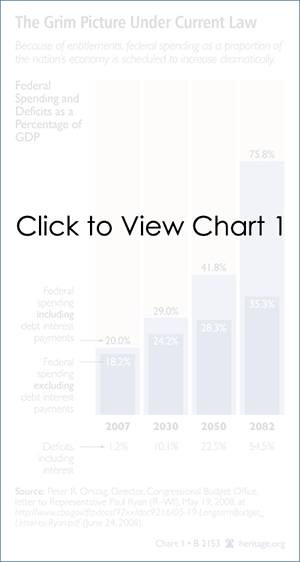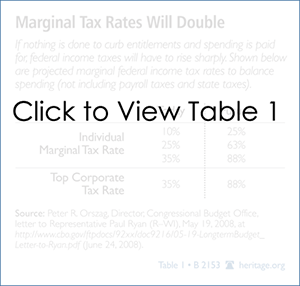Congress's nonpartisan official "scorekeeper," the Congressional Budget Office (CBO), was recently asked by Representative Paul Ryan (R–WI) to estimate the impact of raising marginal tax rates to pay for the projected huge increase in entitlement spending in future decades.[1] The CBO concludes that:
- Marginal tax rates for every bracket, along with corporate tax rates, would need to more than double.
- These tax rates "would significantly reduce economic activity and create serious problems with tax avoidance and tax evasion," and such rates "would probably not be economically feasible."[2]
The CBO was asked to evaluate raising tax revenues as an option to address the huge projected spending and deficits in future years, even though under current law, taxes will rise to record levels as a percent of gross domestic product (GDP).
Spending Under Current Law
As background to its estimates, the CBO notes that spending on Medicare, Medicaid, and Social Security will rise rapidly in the future, pushing up "primary" federal spending (excluding interest payments on the debt) from 18.2 percent of GDP today to 28.3 percent in 2050 and 35.3 percent in 2082. With interest payments included, spending will hit 41.8 percent of GDP in 2050 and 75.4 percent by 2082.
The CBO explains that, if no action is taken to address this and deficits soar to expected levels, "the economy will eventually suffer serious damage."[3]
The Impact of Raising Taxes
The CBO was also asked to examine the economic effects of closing the projected future deficits with an across-the-board increase in individual and corporate marginal income tax rates. In its response, the CBO assumes that no new future programs will be enacted by Congress. (Obviously, assuming any new programs would have required the CBO to increase the needed revenue.)
According to the CBO:
- Tax rates would need to be raised by "substantial" amounts to finance projected spending. Specifically, "[t]he tax rate for the lowest bracket would have to be increased from 10 percent to 25 percent; the tax rate on incomes in the current 25 percent bracket would have to be increased to 63 percent; and the tax rate of the highest bracket would have to be raised from 35 percent to 88 percent. The top corporate income tax rate would also increase from 35 percent to 88 percent."[4]
- "Such tax rates would significantly reduce economic activity and would create serious problems with tax avoidance and tax evasion. Revenues would probably fall significantly short of the amount needed to finance the growth of spending; therefore, tax rates at such levels would probably not be economically feasible."[5]
The CBO also explored a more optimistic scenario by assuming that primary federal spending (excluding interest payments on the debt) would somehow be held constant at 28 percent of GDP after 2030 instead of rising to more than 35 percent of GDP. On this assumption, the CBO estimates that individual marginal tax rates would still need to increase sharply: The 10 percent rate bracket would increase to 19 percent, the 25 percent bracket would increase to 47 percent, and the 35 percent bracket would rise to 66 percent. The top corporate rate also would need to be raised to 66 percent.
The CBO modeled the economic impact of this more optimistic view of future spending and concludes that:
Under this scenario, real GNP [gross national product] per person in 2050 could be between 5 percent and 20 percent less that what it would be if revenues and spending in 2050 were the same shares of GDP as in 2007.[6]
Some Further Points
It is important to remember that in these projections, the CBO:
- Assumes no new programs. Therefore, any new spending program or entitlement that is not offset by reductions in the growth of existing programs would increase projected spending and, hence, the tax rates needed to pay for that spending.
- Excludes payroll and state taxes. The marginal tax rates projected by the CBO include only federal income taxes. They do not include the marginal tax consequences of state income taxes or federal payroll taxes. An individual's actual marginal tax rate is the federal income tax rate plus these other taxes. Assuming that these other taxes will not rise in the future, a middle-income individual subject to a 9 percent state and local tax and 15.4 percent payroll taxes could face a total combined marginal tax rate of 87.4 percent, not just a federal marginal income tax rate of 63 percent. Furthermore, the person facing an 87.4 percent future federal income tax rate could actually incur a total marginal rate of 112.4 percent.
- Assumes that higher rates apply to both rich and poor. These projected marginal rates are based on an across-the-board tax increase. For upper-income people, this means marginal tax rates of over 100 percent. Such rates are not unknown. For instance, when government benefits are reduced because a recipient's income rises—effectively, an extra marginal tax on income—the equivalent marginal tax rate can be higher than 100 percent, usually with very damaging work disincentives. Moreover, if increases in rates for lower-income people were insulated from an across-the-board increase and the top combined rate was kept below 100 percent, middle-class marginal rates would have to be raised even higher than the CBO projects.
Conclusion
The CBO's letter on the tax increases needed to pay for future projected entitlement spending is another dire warning to Congress that it should deal quickly with the unsustainable promises associated with the major entitlement programs. Already, three former CBO directors and many other budget analysts from across the political spectrum have urged a fundamental restructuring of these programs, both to avert an economic crisis and to avoid placing an unacceptable burden on future generations.[7]
Yet proposals abound in Congress and on the campaign trail to create new entitlements and to raise taxes to pay for them in addition to the steadily rising tax burdens built into current law. These new entitlements and proposed tax increases would be on top of the levels that the CBO's letter says would "probably not be economically feasible."[8]
It is time for those who argue that we do not need to renegotiate the promises made in today's entitlements to explain to Americans that their children and grandchildren will face the huge marginal tax rates indicated by the CBO. It is also time for those who advocate increased spending commitments financed by increased tax rates to explain to the American people that future rates would be even higher under their proposals.
Stuart M. Butler, Ph.D., is Vice President for Domestic and Economic Policy Studies at The Heritage Foundation.




